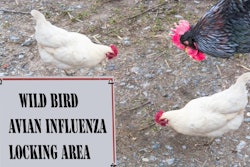
Highly pathogenic avian influenza (HPAI) has returned to the poultry sectors of China and Mexico, and new outbreaks of the disease have occurred in Bulgaria, India, Nepal, and Taiwan.
After an absence of almost seven years, HPAI of the H5N1 subtype has returned to Liaoning province in China. According to the agriculture ministry’s official report to the World Organisation for Animal Health (OIE), the affected farm in the Shenyang district was hit by the infection in the last week of March, leading to the loss of 1,000 birds through mortality, and the destruction of a further 24,472 to control the spread of the disease. Source of the virus is unknown.
The cause of a new HPAI outbreak linked to the H7N3 virus variant in Mexico is also unknown. The country had reportedly been free of the disease for almost one year when there was an outbreak in a backyard flock of 150 birds in early March. All the birds died at the location in the municipality of Acolman, which is part of the greater Mexico City area. The carcasses were disposed of, and the premises were disinfected.
In its official report to the OIE, the agriculture ministry of Mexico notes that vaccination of poultry against HPAI is permitted when authorized by the national animal health agency. This body, SENASICA, reports that surveillance of commercial and backyard poultry in the surrounding area revealed no further dead or diseased birds.
Asia: New outbreaks in India, Nepal, Taiwan
The Odisha state — formerly known as Orissa — in eastern India suffered a series of eight outbreaks of HPAI linked to the H5N1 virus at the end of last year. The disease appears to have surfaced again at a government duck breeding farm in Cuttack, according to the latest Ministry of Agriculture and Farmers Welfare report to the OIE. More than 230 birds of the flock of 924 died, and the rest have been destroyed.
Thirteen of the ducks died on a single day, according to Times of India. As well as more than 600 ducks culled, 6,000 eggs, 66 chickens and 360 kilograms of feed were destroyed.
Since March, Nepal has reported a series of HPAI outbreaks caused by the same virus variant.
Following the mass mortality of around 350 crows in the capital, Kathmandu, in late March, the Department of Livestock Services has been reassuring the public that they should not worry about contracting the disease, reports The Himalayan Times, “as it generally does not kill people.”
There have also been a further three outbreaks of HPAI in Nepal’s commercial egg sector, with the loss of 9,178 birds through mortality or culling. Affected were two flocks of young laying hens, and one of a local breed. Two of the outbreaks were in Koshi — the first in this south-eastern zone — and a further one in previously affected Bagmati.
Taiwan’s ongoing battle to control outbreaks of HPAI linked to the H5N2 virus continues.
Seven new outbreaks during the second half of March were reported to the OIE by the Council of Agriculture. These led to the loss of almost 42,500 poultry through death or destruction to control the further spread of the disease.
The virus was detected at four farms in the Dongshi area of Yunlin county — two flocks of native chickens and two of meat ducks. Two batches of native chickens were observed with suspicious symptoms at a slaughterhouse in the Wanhua distrct of Taipei, and three chicken carcasses found dumped in a natural park in Taipei’s Beitou district also tested positive for the virus.
Taiwan’s animal health agency also reported to the OIE the detection of the virus in a wild heron found dead at a zoo in Beitou in late March. Checks on seven nearby poultry farms revealed all the birds to be clinically healthy, but they will be subjected to enhanced surveillance for the next three months.
Further HPAI outbreaks in Bulgaria
After reporting the return of an H5 HPAI virus to Bulgaria’s poultry sector in mid-March, the agriculture ministry has reported a further two outbreaks to the OIE.
There has been a second outbreak in the province of Lovech, at a farm with 1,400 birds near the city of the same name, and more recently among a flock of almost 35,000 poultry at Asenovgrad in neighboring Plovdiv.
New human H7N9 flu case in China
There has been one new confirmed case of avian influenza A (H7N9) in China, according to the Centre for Health Protection in Hong Kong. At the time of the report, the patient, a man aged 82 in Juiquan in Gansu province, was in a serious condition.
This is the first case of the disease since October of 2018, and brings the total number of confirmed cases since March of 2013 to 1,568.

















